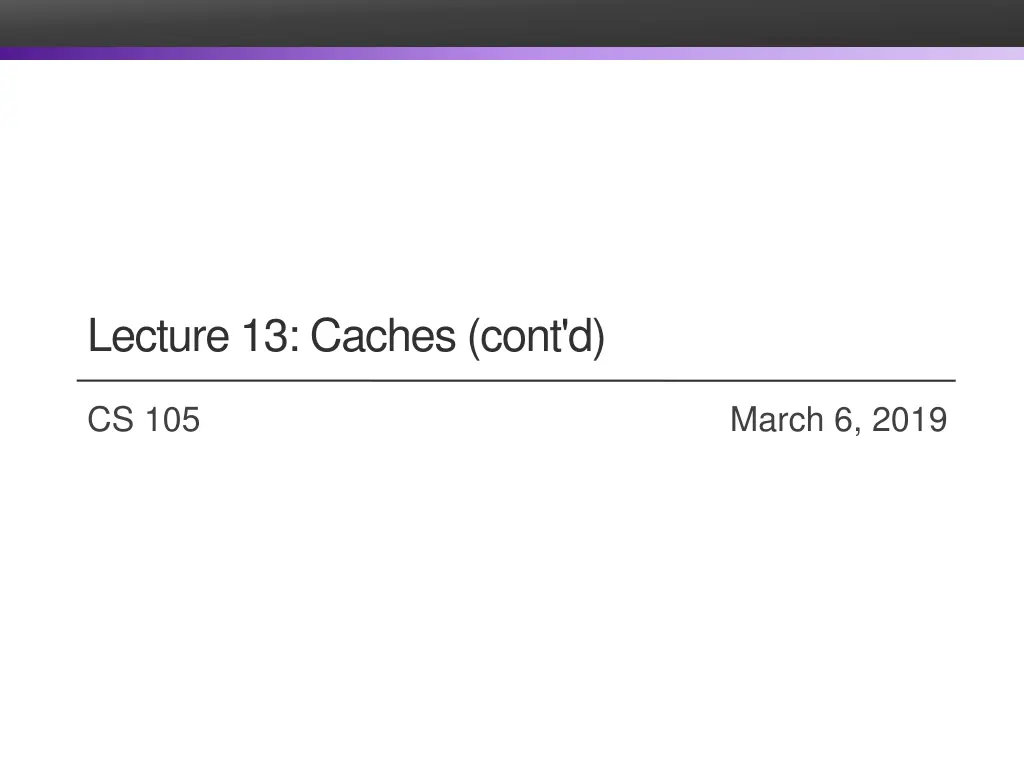
Understanding Caches in Memory Hierarchy
Explore the principles of caches in the memory hierarchy, including levels of cache storage, the importance of locality, cache line structure, and examples of direct-mapped caches. Dive into how spatial and temporal locality impact cache efficiency.
Download Presentation

Please find below an Image/Link to download the presentation.
The content on the website is provided AS IS for your information and personal use only. It may not be sold, licensed, or shared on other websites without obtaining consent from the author. If you encounter any issues during the download, it is possible that the publisher has removed the file from their server.
You are allowed to download the files provided on this website for personal or commercial use, subject to the condition that they are used lawfully. All files are the property of their respective owners.
The content on the website is provided AS IS for your information and personal use only. It may not be sold, licensed, or shared on other websites without obtaining consent from the author.
E N D
Presentation Transcript
Lecture 13: Caches (cont'd) CS 105 March 6, 2019
2 Memory Hierarchy CPU registers hold words retrieved from the L1 cache. L0: Regs L1 cache (SRAM) L1 cache holds cache lines retrieved from the L2 cache. L1: Smaller, faster, and costlier (per byte) storage devices L2 cache (SRAM) L2: L2 cache holds cache lines retrieved from L3 cache L3 cache (SRAM) L3 cache holds cache lines retrieved from main memory. L3: Main memory holds disk blocks retrieved from local disks. Main memory (DRAM) L4: Larger, slower, and cheaper (per byte) storage devices Local disks hold files retrieved from disks on remote servers Local secondary storage (local disks) L5: L6: Remote secondary storage (e.g., cloud, web servers)
3 Principle of Locality Programs tend to use data and instructions with addresses near or equal to those they have used recently Temporal locality: Recently referenced items are likely to be referenced again in the near future Spatial locality: Items with nearby addresses tend to be referenced close together in time
Cache Lines valid bit tag data block v tag 0 1 2 3 4 5 6 7 data block: cached data tag: uniquely identifies which data is stored in the cache line valid bit: indicates whether or not the line contains meaningful information
5 Caching The Organization Address of data: index tag offset 00 An address is decomposed into three parts Low-order b bits, providing an offset into a block (2b is the data block size) Middle s bits, indicating which set in the cache to search (2s is the number of sets) Upper remaining bits, the tag to be matched
6 Direct-mapped Cache Assume: cache block size 8 bytes Address of data: index tag offset v tag 0 1 2 3 4 5 6 7 find line (or set) v tag 0 1 2 3 4 5 6 7 (2 bits for 4-set cache) identifies byte in line (3 bits for 8 byte data blocks) v tag 0 1 2 3 4 5 6 7 tag v 0 1 2 3 4 5 6 7
Example: Direct-Mapped Cache Assume 4-byte data block How well does this take advantage of spatial locality? How well does this take advantage of temporal locality?
Exercise: Direct-Mapped Cache Assume 8-byte data block 0 1 How well does this take advantage of spatial locality? How well does this take advantage of temporal locality?
9 2-way Set Associative Cache E = 2: Two lines per set Assume: cache block size 8 bytes Address of data: index tag offset v tag 0 1 2 3 4 5 6 7 v tag 0 1 2 3 4 5 6 7 v tag 0 1 2 3 4 5 6 7 v tag 0 1 2 3 4 5 6 7 v tag 0 1 2 3 4 5 6 7 v tag 0 1 2 3 4 5 6 7 v tag 0 1 2 3 4 5 6 7 v tag 0 1 2 3 4 5 6 7
Exercise: 2-way Set Associative Cache Set 0 Set 1 Line 0 Line 1 Line 0 Line 1 Line 0 Line 1
11 Eviction from the Cache On a cache miss, a new block is loaded into the cache Direct-mapped cache: A valid block at the same location must be evicted no choice Associative cache: If all blocks in the set are valid, one must be evicted Least-recently used policy; requires extra data in each set Random policy
12 Caching Organization Summarized A cache consists of lines A line contains A block of bytes, the data values from memory A tag, indicating where in memory the values are from A valid bit, indicating if the data are valid Lines are organized into sets Direct-mapped cache: one line per set k-way associative cache: k lines per set Fully associative cache: all lines in one set
13 Caching and Writes What to do on a write-hit? Write-through: write immediately to memory Write-back: defer write to memory until replacement of line Need a dirty bit (line different from memory or not) What to do on a write-miss? Write-allocate: load into cache, update line in cache Good if more writes to the location follow No-write-allocate: writes straight to memory, does not load into cache Typical Write-through + No-write-allocate Write-back + Write-allocate
14 Typical Intel Core i7 Hierarchy Processor package Core 0 Core 3 L1 i-cache and d-cache: 32 KB, 8-way, Access: 4 cycles Regs Regs L1 L1 L1 L1 L2 unified cache: 256 KB, 8-way, Access: 10 cycles d-cache i-cache d-cache i-cache L2 unified cache L2 unified cache L3 unified cache: 8 MB, 16-way, Access: 40-75 cycles L3 unified cache (shared by all cores) Block size: 64 bytes for all caches. Main memory
